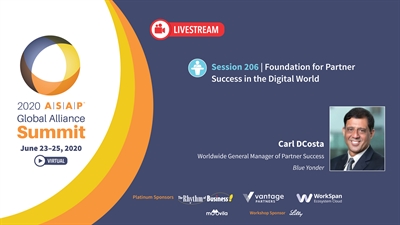Helping Partners Succeed—So That You and Your Customers Do, Too
In an increasingly digital world, how do you create business models that help your company succeed while ensuring that your partners reap the benefits as well?
It’s a question faced by many companies today—not just in technology—and it’s one that is top of mind for Carl DCosta, worldwide vice president and general manager of partner success for Blue Yonder (formerly JDA Software), which provides software and solutions focused on supply chains.
After all, “partner success” is right there in his title.
Building a Partner-Based Model
DCosta’s keynote presentation, “Foundation for Partner Success in the Digital World,” on Wednesday, June 24, 2020, the second day of ASAP’s virtual Global Alliance Summit, looked at how Blue Yonder has approached this question, largely by seeking to understand who their partners are, what their capabilities are, how to attract and recruit new partners, and how to make sure that value is created throughout the ecosystem and flows in multiple directions.
A tech-industry veteran with years of experience, first at HP and then at Oracle, DCosta arrived at Blue Yonder in late 2019 and was given a mandate: build out the company’s channel and partner business. This meant “working more with partners and leveraging the ecosystem,” DCosta said, as well as operating from a “more partner-based model.”
In service of this goal, DCosta divided Blue Yonder’s partners into three types: development partners, who extend solutions; selling partners, who give the company more reach; and delivery partners, who deploy and deliver products and augment Blue Yonder’s expertise.
Each of these partner types needed something different to both attract and enable them.
Needs, Leads, and Sandboxes
The development partners—largely independent software vendors, or ISVs—wanted free licenses and access to technology, OEM (original equipment manufacturer) agreements, and their own “sandboxes” to play in, in the cloud. They benefited from this arrangement by getting high margins with product IP, while Blue Yonder got an end-to-end solution offering.
Selling partners—business or systems integrators (BIs/SIs)—wanted referrals, resell agreements, and co-sell fees and agreements, and thereby they received resale revenue and margin while Blue Yonder got incremental leads, more products, and more users.
Finally, the delivery partners—again, BIs and SIs—wanted enablement and training as accredited technical consultants, as well as branding. Their reward was increased margins for their services business, while Blue Yonder saw their end of the deal as leading to greater customer success.
DCosta noted that unlike in “the old days of reselling,” often companies are more diversified now and may play more than one role—perhaps even all three. Thus it’s important to understand your partners’ capabilities and what they bring to the table—and what you do, too.
Another key point is removing barriers to working together, as much as possible. “We need to be easy to do business with,” DCosta acknowledged. “To be more consumerish, with one click. We want to make it easy technically and commercially to join that journey with us and for us to support [partners]. We’ve got to get better at this.”
Partner Programs Bearing Fruit
So far, DCosta said that the partner programs, processes, and metrics he has worked to implement have been helping in that regard, though he cautioned that it can take a few years for any such effort to truly bear fruit. What’s also important, he said, is to be clear about the nature of the opportunity and to measure the value created thereby—no matter whether the partner is purely transactional, directly pouring revenue into the coffers, or more of an influencer who is bringing in leads.
“What does a win or success mean for each?” he said. “What are you getting out of it, what are we getting out of it? Whatever the win-win is, I encourage you to have a common scorecard.”
Another recommendation DCosta gave was to try to “eliminate channel conflict” and “compensate both the partner and your sales force so they both benefit customers.” He added that sometimes there needs to be more exclusivity in certain geographic regions such as Russia or Latin America, but barring that, he urged compensating and encouraging everyone involved and avoiding what he called the “macho element of human beings: ‘I did the deal and the partner didn’t. I’m better,’ regardless of the compensation. But by and large, if both are mature enough to see the customer as the primary beneficiary that we need to optimize for, then we allow the customer to choose how they procure, and we compensate the partner—especially as the lead—even if the transaction happened through the vendor. Those policies are quite critical to making sure you don’t end up with conflict and you end up with cooperation,” he said.
Not Fade Away: The Future of the Channel
Asked the perennial question about the “death of the channel” and whether the indirect tech sales channel would be wholly replaced by ecosystems, DCosta’s answer was interesting.
“It’s a tough one,” he admitted. “If you mean ecosystems may not resell, and channel by definition equals resell, I do think the dynamics will change. At least in the technology world, ecosystems—or marketplaces if you will—already with a Salesforce or a Microsoft or Oracle seem to be an alternative way to transact from traditional channels or channel players. But everything is a continuum. Some technologies lend themselves to ecosystems better and easier than channels, so I don’t see this as either/or. There certainly is a big shift in the software industry going more toward an ecosystem/marketplace world where the transaction happens more directly.
“But even in that, there’s roles for partners, and especially partners that work across multiple ecosystems—cloud of clouds, as they call it—so there’s plenty of roles for partners and channels to play across multiple ecosystems. It clearly is a trend, but I don’t believe it’s a binary thing where it’ll flip one day and the channels will go away or anything like that. I think there’s a place for both.”

